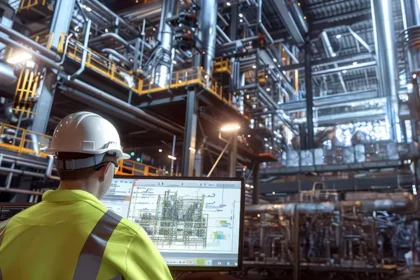Technology is changing the way that the construction industry works and this technology can save time, money, and miscommunications down the road. This brings with it greater benefits for both the consumer and the contractor. We at Nationwide Construction are committed to utilizing the resources that technology has to offer to bring you the best construction service available. Contact us today and start your free building design process.
Positive impacts of construction technology
The construction industry has always strived to build better, stronger, and taller buildings. Construction technology has been a great asset in that endeavour. What we now consider staples at construction sites were revolutionary 50 or 100 years ago. For example, the invention of the mini excavator helped Japan’s housing and urbanization boom in the 1960s when the Yanmar Construction Company created the first wheeled and diesel-powered machine. It replaced labourers using pickaxes and could fit in most areas, even those with restricted access. The same principle is used with construction technology nowadays. New technological advances like mobile apps, drones, and virtual reality can help the construction industry improve productivity, increase worksite safety and create more environmentally-friendly buildings. These innovations also empower Vancouver custom home builders to deliver highly personalized designs and faster project completion times, ensuring exceptional quality and customer satisfaction. But that’s not all construction companies successfully use construction technology for. So, below are listed seven positive impacts construction technology has on construction businesses worldwide.
Mitigates Project Uncertainties
When you can see how the smallest changes affect the overall project outcomes, you’ll improve your project management efforts, and you’ll be able to fix problems faster. Technology enables construction teams to make hypothetical changes to the project and see their impact in real-time to make cost-effective decisions. You can detect any potential errors that might affect the project. In turn, this means you can plan construction activities better and make corrections to existing processes. A great example of effective use of BIM is 22 Bishopsgate in the City of London, the tallest building in the financial district of the UK’s Contributes to Better Building Quality Using high-tech tools and technology ensures greater precision. This means more accurate measurements for foundations, corners, or perimeters but also more detailed mapping of existing structures. All of this greatly contributes to creating and delivering high-quality buildings. But, building new construction is just one area where construction technology can be helpful. Another thing to consider is how to adapt older buildings to become more energy-efficient and structurally stable. When you consider the fact that 80% of the homes people will live in by 2050 have already been built, the construction industry needs to focus on retrofitting older buildings to create more modern and healthier living environments for people. These include improved lighting and HVAC systems, fire safety, and energy standards.
Additionally, this also means adapting and renovating old structures to meet net-zero targets and comply with government environmental regulations. Utilizing construction technology can streamline tasks related to retrofitting buildings, such as enhancing the structural integrity of retaining walls and ensuring energy efficiency.
Enables More Efficient Collaboration
Just a few years ago, construction teams could only rely on emails to make project changes, answer questions, and offer suggestions. Nowadays, with the rise of cloud-based software and mobile apps, communication and collaboration are significantly better. Collecting and storing data in one source that everyone can access enables faster and more efficient collaboration. Different team members can make changes, comment, or respond in real-time. But the best part is that everyone knows how the project is progressing, so important decisions are made with the input from every stakeholder. Contractors, architects, project managers, and clients can work together to finish projects on time and within budget. To clarify this point, companies that use BIM and other construction technology can see improvements in the following areas: Improved design quality Reduced errors and rework Increased percentage of successful projects Improved cost control There has been an 85% improvement in some cases, brought about simply by implementing construction technology to streamline a company’s processes and enable better collaboration. There is more transparency and insight, which creates a positive working environment.
Many construction companies might be hesitant to invest in construction technology due to high costs and a lack of confidence in their own ability to adapt. But when you see the positive impact, it can have on your internal processes and daily operations, the investment proves to be a sensible decision. The most important thing is to do your research and adopt technologies that make sense for your company. Think about processes you can improve and which technologies will give you the most ROI. Remember that companies that stay up to date with the latest technological advancements can create more job opportunities and give more value to their clients.










